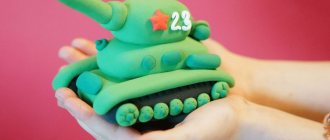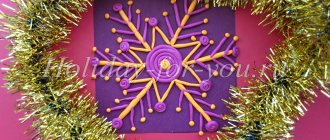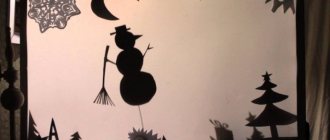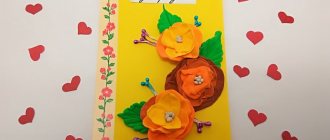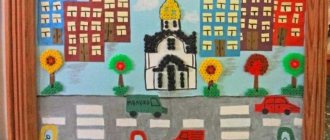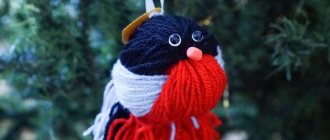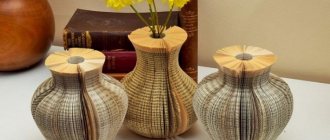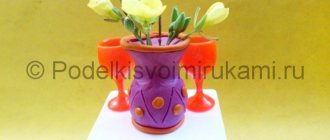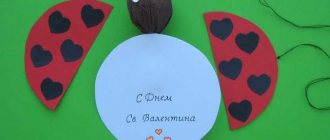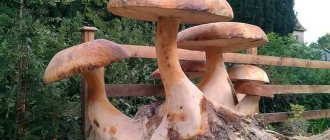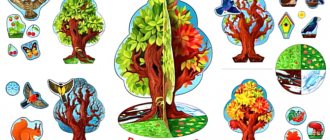Plasticine is a universal and malleable material from which you can make anything. Autumn crafts with plasticine can be made in a variety of directions. You can depict beautiful golden leaves or animals that are preparing for winter. There are an endless number of options, and for some of them simple and more complex master classes will be presented below.
Plasticineography is the art of drawing with plasticine on paper, which is ideal for creating autumn appliqué.
DIY plasticine crafts
Plasticine is a fairly expensive material.
This is especially felt when you need a lot of it. To save on purchases, it is better to make it yourself. In addition, homemade material will be much more pleasant to the touch, and the process of its preparation itself is entertaining for both children and adults. To make homemade plasticine you will need:
- ¼ cup fine salt;
- ½ cup boiling water;
- 1 tablespoon of odorless vegetable oil;
- 1 cup flour.
First, you need to boil water in a saucepan, then add flour and salt to the boiling water and stir the resulting mass with a spoon. After this, place the resulting dense lump on the table, after sprinkling the countertop with flour. Make a small depression in the resulting mass and pour oil into it. Then knead the resulting dough thoroughly (until smooth).
After this, it can be colored using special dyes (food dyes can be used).
The resulting plasticine can be used immediately or saved. To eliminate the possibility of damage, it is necessary to pack it in ziplock bags. This way it will be stored for quite a long time.
Cold porcelain
Master classes and recipes were prepared by Yulia Valerievna Semova, a teacher of additional education at MAOU DO TsRTDiYu, Kamensky district, Penza region.
Cold porcelain is a modeling material that you can make with your own hands. For those who live in a city with a store where you can buy ready-made modeling mass from trusted companies, you don’t have to bother yourself with experiments, but simply buy it.
For rural residents and residents of small towns, this mass will allow them to diversify their work with various hand-made details. The advantages of this mass are its relatively inexpensive cost and availability.
Cold porcelain can be used, for example, to make faces for dolls.
Remember that experience is the son of mistakes, so start with a small amount of materials, study the properties, adapt the tools.
Materials for cold porcelain:
- premium corn starch,
- glycerol,
- Vaseline oil,
- PVA construction glue, the brand is not important, but it should say “PVA dispersion” and contain a plasticizer.
It is immediately necessary to make a reservation that it is not recommended to wear products molded from cold porcelain without acrylic varnish coating; under the influence of moisture, “the carriage turns into a pumpkin...”, that is, the product loses its shape and falls apart. But varnished products are more durable. The magnet has been hanging on the refrigerator for more than six months and the leaf has not lost its shape.
A master class without a video is not worth much, but I will try to explain how I make self-hardening mass for modeling. There are many master classes on this topic on the Internet, I watched many hours before I did the first one. I didn’t cook it, the starch was potato starch, the glue was liquid... The result forced me to look for the right materials (the work is gray and fragile).
Glue with a plasticizer and premium starch also do not guarantee results. I was lucky, I made roses from the first boiled mass and they are still alive... In the summer, however, they were slightly damp from the heat, but they did not fall apart.
So, the main thing in this master class:
Mass recipe
How to make cold porcelain. There are no scales, the main measure is spoons. I cook the mixture in the microwave, so I take a plastic container and follow all the rules for using a microwave:
- Do not place plates with a gold border or iron objects,
- Do not cook in the presence of people sitting nearby,
- do not use the food container anymore,
- ventilate the room!
I first mix the liquid ingredients and heat them in the microwave.
I cook very small portions:
- 2 tablespoons of PVA glue,
- teaspoon glycerin,
- a teaspoon of Vaseline oil,
- on the tip of a spoon of citric acid.
Mix and microwave for 30 seconds. I don’t know anything about the power, I use it for warming up, I calculate it by seconds.
I take it out, mix it and heat it for another 15 seconds.
starch gradually, as much as it takes, like dough (at first I mixed 2 tablespoons without top with cold glue in the same proportion, it turned out a little liquid, I added more, but it turned out that it was better to add it to hot glue).
Now only intuition will tell you that there is enough starch... Stir in quickly, adding little by little. We collect glue from the walls of the container and stir thoroughly.
Place in the microwave for 15 seconds. Whoever has it powerful, then less. Take it out and mix it.
Further, by analogy with the dough - if it is liquid, then add starch.
Warm up a couple more times for 10, 7 or 5 seconds and stir between them. Don't overcook it! Films may appear, just throw them away.
When it has warmed up enough, it begins to form a lump, collect this lump and everything from the walls, place it on a surface greased with rich cream (it’s immediately hot in your hands). Lubricate your hands with Vaseline oil or cream and form the mass like dough, not too stiff, plastic.
At the exit, the mass should be without lumps, stretch well and tear. After complete cooling, remove. If you put it in film, then after an hour we change it so that there are no droplets of condensation.
The mass rests until tomorrow in film and a container, and is also stored only closed, NOT in the refrigerator, just not in the light, in my chest of drawers.
This mass is suitable for small flat and three-dimensional products; I have not tried large sculptures, but it may cause cracks when drying.
How to make autumn crafts from plasticine
Plasticine modeling for children on the theme of autumn is a great idea for creating crafts for kindergarten or school. It can be made in the form of vegetables, which are abundant at this time of year. Animals storing mushrooms and pine cones for the winter can also be no less interesting. An original idea could be an applique that depicts a forest with shimmering autumn colors. In any case, for the craft you will need to stock up on plastic mass, preferably orange, yellow, red, brown and black, as well as a stack, a toothpick and cardboard.
Plasticine mosaic
Children know what a mosaic is and how to play it from the age of three.
Therefore, it is not difficult for them to understand how to fill silhouettes from the inside with plasticine balls.
- Adults can only prepare templates for drawing and visual material in the form of pictures.
- The difficulty of appliqués made from small pieces is that the manufacturing process takes a week.
- But such a drawback does not affect the mood of preschoolers; their interest in the craft does not disappear.
What applications should I make?
Both kids and children from the younger group can make beautiful applications with their own hands step by step.
To create this autumn craft from plasticine you will need cardboard or thick paper. The process of sculpting such a picture consists of five stages.
- To begin with, you need to roll thin flagella of different lengths from yellow, red and orange plasticine.
- They need to be formed into spirals.
- These small parts are attached to cardboard. The crown of the tree is formed from them. The spirals need to be arranged in a chaotic manner. In this case, the autumn tree will look more natural. Each of the elements needs to be lightly pressed onto the cardboard.
- You need to fashion denser and wider flagella from brown plasticine. They are attached to the bottom of the craft and act as tree trunks. To make the base look neater, it needs to be slightly trimmed with a stack.
- From the remains of yellow, red and orange plasticine you need to form spiral leaves that will fill the space at the bottom of the picture. Some of the colored parts should be made more blurry by pressing them onto the cardboard and slightly smoothing the edges.
You can fill the free space with blue, purple and white details. They are attached to the paper and lightly smeared on it. This landscape looks like a full-fledged postcard.
Maple leaf
This craft for preschoolers can become part of a postcard or a large flower arrangement. To sculpt a colored maple leaf, you need to use white paper, several pieces of light plasticine of different colors and scissors. The technology for creating such crafts is very simple.
- To begin, cut out a maple leaf of the required size from a piece of cardboard.
- Several small parts need to be cut from blocks of plasticine of different colors.
- Each of these pieces needs to be kneaded and laid out on paper in a chaotic manner.
- All these details must be smeared over the surface, carefully mixing the colors. Transitions between different shades should be smooth.
This fall themed maple leaf can be further decorated with black dots to make it look more natural.
Gifts of Autumn
You can also depict a still life consisting of autumn vegetables, fruits and mushrooms on cardboard. The autumn harvest looks bright and impressive. You can see this in the example of a craft depicting a basket of mushrooms. Here are step-by-step instructions for creating it.
- First you need to make the main part of this application - the basket. It needs to be sculpted from a large piece of brown plasticine.
- A flat semicircle is attached to cardboard and decorated using a stack.
- You need to make a handle from orange and brown flagella. It turns out more voluminous.
- Once the basket is ready, you can start sculpting the mushrooms. They are made from plasticine of different colors. Each mushroom consists of a cap and a stem.
- You can place mushrooms in different parts of the application.
Green leaves and small snails will complement the picture. A composition created from fruits and berries will also look beautiful. It can be completely sculpted from plasticine or drawn, and then supplemented with three-dimensional details.
The craft consisting of apples, pears and blue grapes looks beautiful. It is complemented by voluminous green leaves.
Lily of the valley step by step with photo
We form many white balls of different sizes. Make indentations using the end of the brush. We fashion a long rope of green color, which gradually tapers towards the top. At the very end, add 5 white balls - from smallest to largest. Attach flowers. We make two large sheets and press the veins on them. We wrap them at the base of the stem. Lily of the valley can be mounted on cardboard.
Basic techniques for modeling with plasticine
The diverse forms of appliqué elements and crafts require careful thought about execution techniques. This is the task of helping kids master the simplest techniques for creating shapes. The simplest forms of creation in modeling are:
- rolling - circular movement of palms against each other, pressing plasticine, to form a ball;
- rolling - direct movements of the palms against each other, turning the ball into a cylinder;
- flattening - pressing the formed ball between the palms, or to the surface of a table or modeling board;
- pinching – execution of small details on large appliqué figures. This is squeezing a small amount of plasticine (a pinch) with your fingers, usually on the edge of the product;
- smoothing - connecting several elements of a product to each other by rounding the joints with plasticine with your fingers.
Cactus - a simple MK for children
Let's prepare plasticine, a pot and a match. Fill the pot with plasticine. We insert a match as a frame and string a green ball onto it. We press the strips and sculpt the spines. Place a yellow flower on the very top of the cactus. 1st grade children can easily cope with such an interesting craft.
What you need to make plasticine crafts
The main element in modeling is plasticine. When working with children, you should choose the right plasticine, since for young children it will be difficult to warm up and roll out rough and dry plasticine, and children will not like this activity. Consider the age of the children. Today, in art shops and stationery stores there is a lot of material for different age categories of children. In addition to plasticine, you will need:
- Stacks are usually plastic knives for cutting plasticine, which are included in plasticine packaging, in a standard shape. If desired, you can purchase stacks of more complex shapes and from a different material: wood or metal.
- modeling board – needed for forming individual elements of crafts, appliques, and cutting plasticine.
- all kinds of improvised means are necessary for decorating and making crafts. These can be: toothpicks, paper clips, pens, buttons, beads, beads, and various objects with good texture to transfer texture to plasticine.
Water lily - modeling scheme
We make a green circle and divide it into 6 equal parts. We cut out one of them with a stack. We make 7 yellow petals in the shape of drops and attach them to a green leaf. Add 7 more petals on top and slightly curl them up. We place many red balls in the center of the lily. Such a water lily can be made from light plasticine.
How to sculpt autumn from plasticine
To make autumn from plasticine, you will need the material itself, A-4 cardboard, a board, stacks, pencil, scissors, PVA glue and a ruler. On cardboard you need to draw a circle with a radius of 15 centimeters. From the entire circle you will only need a part from which you will need to glue the cone. Then this cone is covered with plasticine of any color. After this, a ball for the head is molded.
You should prepare plasticine leaves for the Autumn dress. To do this, you need to make a ball, then make an oval out of it, which must be flattened to give the shape of a leaf. Make several leaves and cut veins into them. After this, paste the prepared leaves over the cone (it is advisable to start from the bottom and attach the leaves to the very top).
Next, attach the head to the cone and glue a crown of the same, but smaller, leaves onto it. Then you need to make eyes, a mouth, a nose, two hands and also attach them to the cone.
The main part of the craft at this stage is considered complete. To give the picture a mood, you can use your own creative idea and decorate Autumn with a variety of beads, ribbons, buttons, beads and other small details.
This craft is perfect for presentation at a competition in kindergarten or elementary school.
Plasticine painting from flagella
A subject or subject picture with plasticine flagella looks much more realistic than a simple applique. Thin sausages are rolled out from pieces between the palms or squeezed out using a syringe.
The second method is beyond the capabilities of younger preschoolers, so adults make such preparations themselves. And the children twist them into a spiral or snake and glue them onto cardboard.
Craft materials:
- Outline illustration from a coloring book. You can also draw your own design on cardboard by hand or using templates.
- Soft plasticine in the desired colors.
- Medical syringe with a volume of 5–10 ml.
- Container with hot water.
Options for modeling from plasticine, autumn theme, photo
Autumn tree made of plasticine and dried oak leaves
Plasticine panel “Autumn”
Plasticine applique “Hedgehog in the autumn forest”
Composition from plasticine “Autumn meadow”
Autumn landscape, plasticineography
Violet - making an indoor flower
Take a small container and put green plasticine there. Make light green leaves and place them in a container. We form purple petals. We make flowers out of them and add yellow centers. The result is a plasticine basket with flowers.
Plasticine painting “Golden Autumn”
Let's create a simple small painting on the theme of autumn, using a combined modeling technique throughout the work.
To create a picture you will need materials and tools:
- one sheet of blue cardboard;
- plasticine of several colors: yellow, brown, orange, red, blue and green for the frame;
- stack;
- board for working with plasticine.
Execution:
- From plasticine of yellow, orange, red colors, roll out ropes or long sticks 3-5 mm thick, of different lengths.
- We roll the resulting flagella into a spiral (snail) along the entire length of the bundle. You will get “snails” of different sizes and colors. These are elements of the future tree crown.
- On a sheet of cardboard we form the crown of an autumn tree from the resulting “snails”. Fantasy will help here. You can place larger elements in the center of the crown, and small ones along the edges of the product. Pay attention to the placement of flowers along the crown of the tree, since by getting involved in the process, you may end up with a single-color crown on one side and the other. We fix the elements on the cardboard, slightly pressing each element onto the cardboard.
- Roll out brown plasticine into flagella of approximately the same length. You will need approximately 4-6 bundles, it depends on the volume of the prepared tree crown.
- We form a tree trunk from the bundles. We place the bundles tightly to each other, trimming them with a stack, to create smooth edges. We place the tree trunk under the crown, in the center. We bend the outer strands of the trunk slightly to the sides towards the crown, as if the branches of a tree go into the crown. We trim the bottom of the trunk with a stack.
- Let's roll out a few more strands of different colors: yellow, red, orange. Let's place them at the bottom of the picture, under the tree trunk, in the form of waves, placing them tightly together. These are fallen leaves from a tree.
- From two colors to choose from (we prepared blue and green), we will decorate the frame along the contour of the picture. The frame can be made simply with two colored stripes, or you can twist the strips in the form of a pigtail and also place it along the contour. Press the frame well against the cardboard.
The plasticine painting “Golden Autumn” is ready. You can congratulate her relatives in the coming autumn.
Lily step by step
Let's make a yellow lily step by step. We roll a dark yellow rope and wrap it with a light yellow one. Cut into 6 equal pieces. In order to make a petal, we sculpt a piece in the shape of a boat and make a small protrusion in the center of the petal. We make black specks on each petal. We twist the stamens from the wire and attach them to the stem. Add petals. We attach a ball to the tip of each stamen. We make leaves.
Autumn motifs in the works of children
You can make working on a craft interesting for children if you take into account their capabilities. Therefore, I will try to show the works according to age level. I'll start with our work. For the tree, I rolled plasticine balls, and my son flattened it and drew a pattern on the leaves with a knife.
But a caterpillar is several circles gathered together and attached one after the other. To give strength to the structure, place all individual fragments on a toothpick. And, if you want the caterpillar to be flexible, put the balls on a needle and pull it along the thread. When all the parts are assembled, cut the thread at the needle itself, and embed its tip in plasticine.
You can, as this master class shows, make a caterpillar rainbow.
And don’t forget about the design of the face and the paws! By the way, here the circles are simply attached to each other. And this option is also suitable.
Older children want to show their talent more fully. For example, a preparatory group in a kindergarten can start making a real autumn meadow, where mushrooms grow and animals run around.
This is the kind of application we will make too.
- In the middle of the leaf we make a tree trunk. We select the shape and color. For example, birch can be white and slightly curved.
- Branches extend from the trunk.
- To make our tree more like a birch tree, we make “spots” by pressing holes (not through holes) with a small object.
- You can complement the picture with several black spots.
- We tear off the “leaves” from the yellow plasticine and glue them around the branches.
- It's autumn, which means there are also a lot of fallen leaves on the ground.
- Mushrooms grow around. They have a semicircular cap and short legs.
- There is a Christmas tree next to the birch tree. Glue a semicircle at the bottom. We divide this “skirt” into strips with a special knife. And so on for each top ball.
- There must be a hedgehog near the mushrooms. It is made like a droplet, only the nose is slightly turned up.
- Separate the part where the hedgehog has needles and draw many, many stripes.
- The hedgehog is already with the harvest. Glue a small fungus onto its needles.
- The bunny is standing by the Christmas tree. It has a head with long ears, a body, legs and a tail.
- Autumn heavy clouds and flying birds complete the picture.
- Author of the master class
Of course, if it is difficult for the baby to do something from this, you can skip this detail.
Such a picture can be done by children from 3 years old, however, if the child is assiduous. But 4-5 year olds can easily cope with this task.
Of course, it will be much easier if mom helps roll the balls.
Lilac - step by step modeling scheme
We roll large and small balls from different shades of lilac. We divide the small balls into four parts, and from the larger ones we fashion wavy petals and collect them into four-leaf flowers. Take a piece in the shape of an elongated drop and stick 3 balls on it. Add flowers of different sizes and shades. At the very end we attach balls with slots. Use an awl to make indentations in the flowers. Place the yellow center in each cavity. We stick a branch and leaves in the shape of a heart.
Plasticineography Autumn for primary school children. Master class with step-by-step photos
DIY plasticine painting. Master class: Autumn palette
Target audience: children 6-9 years old
Purpose: making a painting as a gift
The purpose of the master class: to perform decorative and applied work using the “Plasticine painting” technique.
Tasks:
Learn:
Learn new techniques for working with plasticine (pressing, smearing, etc.)
Develop:
- Develop the emotional sphere, creative thinking, imagination and fantasy.
- Develop fine motor skills.
Educational:
To foster independence, creativity, and aesthetic feelings in children.
Plasticineography is classified as an unconventional art technique; it involves drawing with plasticine on cardboard or any other dense base. The background and characters are depicted not by drawing, but by sculpting, while objects can be more or less convex, semi-volume. Working with plasticine helps the child express emotions, his vision of the world around him and his attitude towards it, form aesthetic taste, develop flexibility, coordination, fine motor skills of the fingers (which in turn contributes to speech development).
The child gradually learns perseverance, patience, accuracy, and the ability to always complete work. When working with plasticine, it is necessary to take into account its properties: softness, plasticity, adhesiveness, ability to soften under the influence of heat, fragility, ability to retain its given shape, water resistance.
Reminder when working with plasticine:
- For the base, it is necessary to use thick cardboard so that it does not deform when performing techniques of pressing, smearing, smoothing, and flattening.
- To work with a three-dimensional form, stacks are needed to highlight the characteristic features of a decorative object. 3. Working with plasticine is labor-intensive and requires effort, so in the process of doing it, children need rest in the form of thematic physical education minutes and warm-ups. 4. There must be a damp cloth for hands on the child’s desk so that he can use it at any time, and after completing the work, first wipe his hands with the napkin, and then wash his hands with soap and water.
Plasticineography develops children's creativity (primarily visual) - after all, with the help of this technique you can create an original, unique image with vivid expressiveness.
Master Class
Early autumn is the most wonderful time of the year! That is why many artists and poets tried to glorify its beauty in their works. We, inspired by the variety of autumn colors, will also create our own picture, which will resemble the artist’s palette. For work we will need the following tools and materials: 1. Plasticine 2. Stacks 3. Thick cardboard 4. Simple pencil 5. Paper napkin
Before starting work, use light strokes to sketch the intended design on thick cardboard with minimal elaboration. Let's start working with the long shot. We paint the forest using green paint in two shades - light and dark. To do this, apply strokes with your fingers. We use pressing and smearing techniques.
Let's move on to the image of the forest in the foreground. For this we need green and yellow plasticine. To obtain the desired yellow-green shade, we use the technique of infusing one color into another. To do this, we use two methods. The first is to mix the plasticine directly on the base, applying strokes alternately. Second - we take several pieces of plasticine of different colors, knead them, mix them in one ball and draw.
In order to highlight the colors of the autumn forest, we selectively add orange using the same technique. To draw houses, we take white, red and black plasticine. The roofs of the houses will be as bright as the foliage of the trees. Using black we will emphasize the shape of the houses and give clarity to the contours. To indicate the shadow we use blue and dark gray colors.
Let's draw a road. To depict it, we need a smooth texture of strokes. We use the smoothing technique. We use the following colors: yellow, brown, orange. On the left and right we paint the ground with yellow and green. To do this, we again use the technique of pouring one color into another. We place the strokes in a certain direction. To emphasize the relief of the earth, highlands and lowlands, we add dark green color in some places. To fill the sky we use white and blue plasticine. First, cover the entire area with light blue. To make it, you need to mix white and blue plasticine into one ball. Then selectively add dark blue color, smearing it in a circular motion, giving shape to the airy clouds. Let's move on to a more detailed study of the picture. We return to the forest. To show the structure of tree foliage, it is necessary to make the texture more prominent. To do this, we use stacks to add various strokes and curves. In the right places we add the required color of plasticine, using the techniques of pinching, flattening, pulling and smearing. To add depth to the crown, add black color. We also use a dark color to indicate the shadow of the trees. Let's draw grass in the foreground. We will need green plasticine in different shades. To depict grass we will use the rolling technique and the slapping technique. On the left is the shadow side, therefore the grass will be darker. On the right is the sunny side, which means that for the grass we use a color that is a shade lighter. Then we apply highlights with white plasticine; to emphasize the autumn season, we add yellow strokes here and there. Use a stack to shape the grass. The picture is ready. The autumn forest, playing with colors, Weaves wreaths from the crowns of trees, Pampering warm days with its sunny caresses. Close-up of the sky. Close-up of houses.
Close-up of the road.
The technique of drawing with plasticine is fascinating not only for children, but also for adults. Creativity should bring the joy of communication, knowledge, work and relaxation. I wish you creative success!
Hedgehog with seed needles
For this craft you need to take plasticine, sunflower seeds and glass. First, you need to roll two balls of different sizes from a dark color, one for the body, the other for the head. Form a head from the smaller ball, sharpening it on one side. After smoothing out the shape of the muzzle, roll the larger ball into an even ball for the body. Then connect the two parts together. After this, attach the previously prepared eyes and nose to the muzzle and move on to the needles.
To attach the needles, you need to stick the seeds one by one into the hedgehog’s body with the sharp ends down. The seeds need to fill the entire surface of the hedgehog's body.
Next, you need to make mushrooms, apples and yellow and red leaves from the material. This will add an autumn mood to the picture and will correspond to the given theme.
To make leaves, you need to roll out the plasticine and select, for example, the shape of a maple, separating the excess material. To make the leaves in the picture look neat, draw veins on them in a stack. After this, move on to sculpting mushrooms or apples.
To form an apple, you need to roll a red even ball, sharpening it slightly at the bottom, and attach a small green plasticine leaf on top. To sculpt a fungus, you need to roll out a thick stick from white plasticine, which will serve as a leg.
For the cap, form an oval and flatten it on both sides. Then fasten the cap and stem, placing the resulting figures on the hedgehog’s needles. The craft is ready!
You can also make a hedgehog in the form of an applique . To do this, you need to cut out an animal template from cardboard and cut it out. Then cover the back of the future hedgehog with brown color and poke seeds into the plasticine, filling the surface.
Make a mouth, nose, eye and eyebrow from white and black colors, attach all the details to the muzzle. After which the craft can be decorated with various leaves, twigs and other details reminiscent of autumn.
